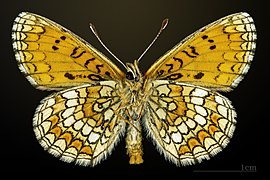| Melitaea parthenoides | |
|---|---|

| |
| Conservation status | |
 Least Concern (IUCN 3.1) | |
| Scientific classification | |
| Domain: | Eukaryota |
| Kingdom: | Animalia |
| Phylum: | Arthropoda |
| Class: | Insecta |
| Order: | Lepidoptera |
| Family: | Nymphalidae |
| Genus: | Melitaea |
| Species: | M. parthenoides |
| Binomial name | |
| Melitaea parthenoides C. Keferstein, 1851 | |
| Synonyms | |
| |
Melitaea parthenoides, the meadow fritillary, is a butterfly of the family Nymphalidae. Note that the common name meadow fritillary is also used for the North American species Boloria bellona.
Distribution
It is found in south-western Europe, more specifically on the Iberian Peninsula, south-western France, parts of the Italian Alps and southern and south-western Germany and a few regions of Switzerland.
Description
The wingspan is 28–34 mm. Upper surface very similar to Melitaea athalia, especially in pattern, but the black markings much thinner, yellowish red the prevalent colour. While in Melitaea aurelia and athalia the yellowish red spots may be said to be united to bands, parthenoides has orange bands of almost even width and traversed by thin black veins; the median band especially is very broad, the spots composing it being almost twice as long as wide, which is hardly ever the case in European athalia. The underside likewise resembles athalia in pattern, but is brighter, more variegated, the black edges of the various bands being more prominent, the colours contrasting more distinctly.
Biology
In dry, favourable climates, adults are on wing in two generations, from May to June and from August to September. At high altitudes, there is one generation from June to July. The larvae feed on Plantago species, mainly P. lanceolata.
References
- van Swaay, C., Wynhoff, I., Verovnik, R., Wiemers, M., López Munguira, M., Maes, D., Sasic, M., Verstrael, T., Warren, M. & Settele, J. (2010). "Melitaea parthenoides". IUCN Red List of Threatened Species. 2010: e.T173315A6989319. doi:10.2305/IUCN.UK.2010-1.RLTS.T173315A6989319.en. Retrieved 23 January 2024.
{{cite journal}}: CS1 maint: multiple names: authors list (link) - Keferstein, C. (1851). "Versuch einer kritisch- systematischen Aufstellung der europäischen Lepidopteren mit Berücksichtigung der Synonymie". Stettiner Entomologische Zeitung. 12: 244.
- Seitz. A. (1909). Die Großschmetterlinge des palaearktischen Faunengebietes, Die palaearktischen Tagfalter Band 1: Abt. 1
 This article incorporates text from this source, which is in the public domain.
This article incorporates text from this source, which is in the public domain.
External links
- lepiforum.eu
- "Melitaea Fabricius, 1807" at Markku Savela's Lepidoptera and Some Other Life Forms
- Fauna Europaea
| Taxon identifiers | |
|---|---|
| Melitaea parthenoides | |
This Nymphalinae article is a stub. You can help Misplaced Pages by expanding it. |



